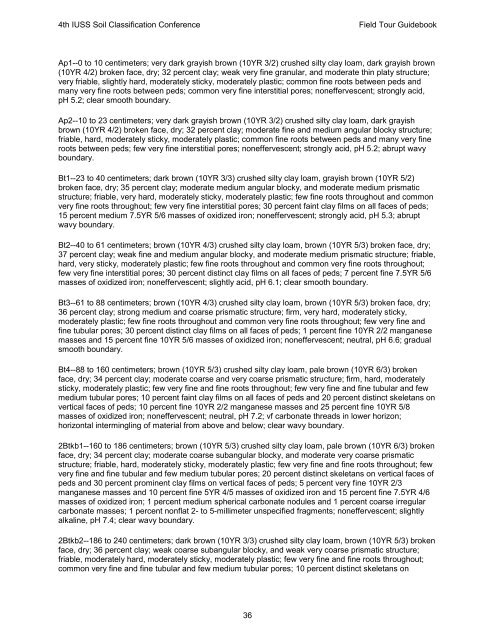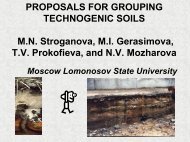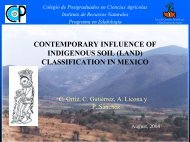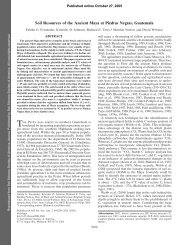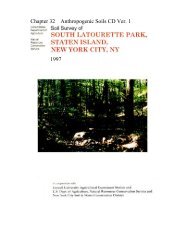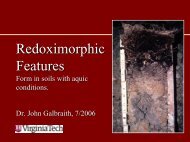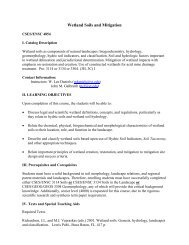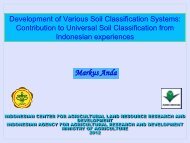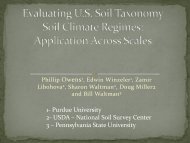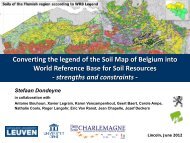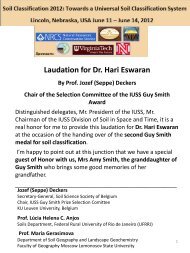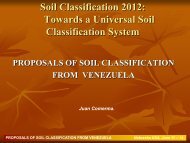Nebraska Soils Field Trip - Virginia Tech
Nebraska Soils Field Trip - Virginia Tech
Nebraska Soils Field Trip - Virginia Tech
You also want an ePaper? Increase the reach of your titles
YUMPU automatically turns print PDFs into web optimized ePapers that Google loves.
4th IUSS Soil Classification Conference <strong>Field</strong> Tour Guidebook<br />
Ap1--0 to 10 centimeters; very dark grayish brown (10YR 3/2) crushed silty clay loam, dark grayish brown<br />
(10YR 4/2) broken face, dry; 32 percent clay; weak very fine granular, and moderate thin platy structure;<br />
very friable, slightly hard, moderately sticky, moderately plastic; common fine roots between peds and<br />
many very fine roots between peds; common very fine interstitial pores; noneffervescent; strongly acid,<br />
pH 5.2; clear smooth boundary.<br />
Ap2--10 to 23 centimeters; very dark grayish brown (10YR 3/2) crushed silty clay loam, dark grayish<br />
brown (10YR 4/2) broken face, dry; 32 percent clay; moderate fine and medium angular blocky structure;<br />
friable, hard, moderately sticky, moderately plastic; common fine roots between peds and many very fine<br />
roots between peds; few very fine interstitial pores; noneffervescent; strongly acid, pH 5.2; abrupt wavy<br />
boundary.<br />
Bt1--23 to 40 centimeters; dark brown (10YR 3/3) crushed silty clay loam, grayish brown (10YR 5/2)<br />
broken face, dry; 35 percent clay; moderate medium angular blocky, and moderate medium prismatic<br />
structure; friable, very hard, moderately sticky, moderately plastic; few fine roots throughout and common<br />
very fine roots throughout; few very fine interstitial pores; 30 percent faint clay films on all faces of peds;<br />
15 percent medium 7.5YR 5/6 masses of oxidized iron; noneffervescent; strongly acid, pH 5.3; abrupt<br />
wavy boundary.<br />
Bt2--40 to 61 centimeters; brown (10YR 4/3) crushed silty clay loam, brown (10YR 5/3) broken face, dry;<br />
37 percent clay; weak fine and medium angular blocky, and moderate medium prismatic structure; friable,<br />
hard, very sticky, moderately plastic; few fine roots throughout and common very fine roots throughout;<br />
few very fine interstitial pores; 30 percent distinct clay films on all faces of peds; 7 percent fine 7.5YR 5/6<br />
masses of oxidized iron; noneffervescent; slightly acid, pH 6.1; clear smooth boundary.<br />
Bt3--61 to 88 centimeters; brown (10YR 4/3) crushed silty clay loam, brown (10YR 5/3) broken face, dry;<br />
36 percent clay; strong medium and coarse prismatic structure; firm, very hard, moderately sticky,<br />
moderately plastic; few fine roots throughout and common very fine roots throughout; few very fine and<br />
fine tubular pores; 30 percent distinct clay films on all faces of peds; 1 percent fine 10YR 2/2 manganese<br />
masses and 15 percent fine 10YR 5/6 masses of oxidized iron; noneffervescent; neutral, pH 6.6; gradual<br />
smooth boundary.<br />
Bt4--88 to 160 centimeters; brown (10YR 5/3) crushed silty clay loam, pale brown (10YR 6/3) broken<br />
face, dry; 34 percent clay; moderate coarse and very coarse prismatic structure; firm, hard, moderately<br />
sticky, moderately plastic; few very fine and fine roots throughout; few very fine and fine tubular and few<br />
medium tubular pores; 10 percent faint clay films on all faces of peds and 20 percent distinct skeletans on<br />
vertical faces of peds; 10 percent fine 10YR 2/2 manganese masses and 25 percent fine 10YR 5/8<br />
masses of oxidized iron; noneffervescent; neutral, pH 7.2; vf carbonate threads in lower horizon;<br />
horizontal intermingling of material from above and below; clear wavy boundary.<br />
2Btkb1--160 to 186 centimeters; brown (10YR 5/3) crushed silty clay loam, pale brown (10YR 6/3) broken<br />
face, dry; 34 percent clay; moderate coarse subangular blocky, and moderate very coarse prismatic<br />
structure; friable, hard, moderately sticky, moderately plastic; few very fine and fine roots throughout; few<br />
very fine and fine tubular and few medium tubular pores; 20 percent distinct skeletans on vertical faces of<br />
peds and 30 percent prominent clay films on vertical faces of peds; 5 percent very fine 10YR 2/3<br />
manganese masses and 10 percent fine 5YR 4/5 masses of oxidized iron and 15 percent fine 7.5YR 4/6<br />
masses of oxidized iron; 1 percent medium spherical carbonate nodules and 1 percent coarse irregular<br />
carbonate masses; 1 percent nonflat 2- to 5-millimeter unspecified fragments; noneffervescent; slightly<br />
alkaline, pH 7.4; clear wavy boundary.<br />
2Btkb2--186 to 240 centimeters; dark brown (10YR 3/3) crushed silty clay loam, brown (10YR 5/3) broken<br />
face, dry; 36 percent clay; weak coarse subangular blocky, and weak very coarse prismatic structure;<br />
friable, moderately hard, moderately sticky, moderately plastic; few very fine and fine roots throughout;<br />
common very fine and fine tubular and few medium tubular pores; 10 percent distinct skeletans on<br />
36


